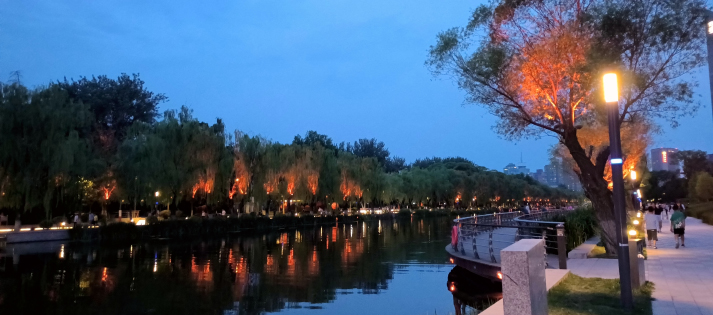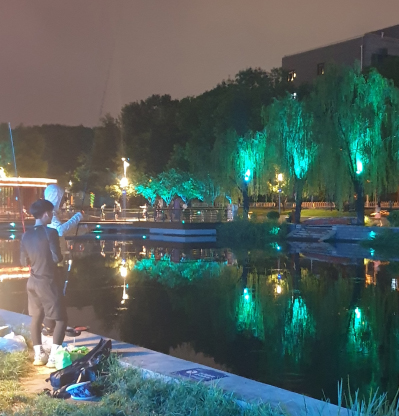What do Beijingers do once the sizzling summer sun sets?

Taking in the summer night sights at the Liangma River in Beijing’s largest urban district, Chaoyang, in late June (LU YAN)
A whip cracks in the hot and humid summer night air encasing China's national capital in late July. Two sixty-something men each hold a long, leather whip with which they are spinning a large, stone top. They get the top whirling and twirling by wrapping the whip around it, placing it on the pavement and then pulling the whip like a ripcord. As the top begins its wild spin, the men lash it with booming cracks of their whips to keep it going.
In addition to these sonic snaps, the same airwaves carry aloft massive kites sporting tails bejeweled with colorful flashing LED lights to increase visibility and visual flair. Also in the air are the sounds of babyboomers, sexagenarians and septuagenarians, belting out the hits with the aid of portable karaoke machines they have parked on the pavement. Close by, a young family—mom, dad and their two teenagers—enjoy a fruity dessert picnic while playing a game of mahjong.
This is Beijing… After dark.
As this author passed through this scene on her nightly run, a thought suddenly passed through her mind: What do people outside the city actually know about the favorite daily pastimes of Beijingers—once the scorching summer sun has set?
We find ourselves on the banks of the Liangma River in the popular Sanlitun commercial area of the capital's largest urban district, Chaoyang. Since summer 2022, the Liangma, winding its way through central Beijing, has become a hot spot for Beijingers to spend some off time. Both locals and expats flock here to squeeze a workout into their daily rush, to go night fishing, to hone their tai chi skills, to partake in a jam session, or to flaunt along the waterfront sights with lights switching from blue to green to purple to red casting a social media-friendly glow over the scenery.
The area's evening allure becomes even hotter during the city's sweltering summer months.

A Beijing park after sunset in May 2020: On the one hand, two women dressed in hanfu, the traditional dress of the Han Chinese; and on the other, a group of enthusiasts partaking in some public jazzercise (CNSPHOTO)
Picking up the pace
As the old Chinese adage goes, fanhou baibuzou, huodao jiushijiu—literally, "take 100 steps after a meal and you'll live to be 99." According to science, walking after eating helps with digestion by stimulating your stomach and intestines, making your food move through you more quickly. And while many may be quick to assign the post-meal stroll to the older generations, reality tells a different story.
Postprandial walks are popular with young and old, from the banks of the Liangma and the city's busy shopping districts, to the quiet hutong alleyways in the city's old neighborhoods. From octogenarian couples carefully locking arms so as to not be run over by the ubiquitous delivery drivers dashing along the streets and sidewalks, to twentysomethings who pause their pace to indulge in a cool slice of watermelon sold by a lonely street vendor, these night-time strollers take their digestion—and potential longevity—seriously.
And then there are those who choose to up the pace, including this author. In the last few years, a running boom has hit the world's most populous nation. According to Runner's World magazine, upward of 20 million Chinese today are exuberantly taking to the urban streets and village trails (and river banks) to get that runner's high.
The concept of yepao or "nighttime running," in particular, has taken flight among China's millennials and Gen Zs in the past five years. Finding time in a busy work schedule, embracing the cold winter nights and avoiding the scorching summer heat are all reasons runners are heading out after dark. No matter their motivation, on any given night, the Liangma's banks, specifically, will brim with lycra-clad runners stretching their hamstrings and sporting an array of headphones and fitness trackers.
But yepao isn't the only healthy after-dark pastime you will encounter on the capital's streets.

Taking in the summer night sights at the Liangma River in the popular Sanlitun commercial area of Beijing’s largest urban district, Chaoyang, in late July. The waterfront’s lights switching from blue to green to purple to red cast a social-media-friendly glow over the scenery (ELSBETH VAN PARIDON)
Mens sana in corpore sano
Residents here are accustomed to the sights and sounds of dozens of middle-aged and senior Chinese women getting in formation to dance in the parks and open spaces dotting the urban landscape. All year round, thousands of women partake in a little guangchangwu, or "public square dancing," twisting their way to physical and mental agility. These groups are a cultural mainstay, but it seems their shimmying shenanigans are starting to charm younger generations as well. As per this author's observations in her own habitat of Sanlitun, the dancing styles have evolved from your typical slow traditional Chinese square dancing, to a high-energy, rhythmic dance more reminiscent of disco.
Public jazzercise is also a thing, and after the sun has set, one can see old and young(er), men and women, getting into the groove around the city including one subway square in Xicheng District, downtown Beijing, where yours truly photographed some 80 people throwing themselves, arms flailing about, into a dance workout routine in late July.
Speaking of arms, but hold the flailing, baduanjin is one of the common forms of Chinese qigong, a mind-body exercise that uses meditation, breathing and movement to increase energy. Baduanjin, which translates as Eight Pieces of Brocade or Eight Silken Movements, refers to how the eight individual movements of the qigong form characterize and communicate a silky-smooth quality (like that of a piece of brocade to the body and its energy).
Baduanjin is gaining popularity among young Chinese who, aside from a growing awareness of the importance of physical fitness, also tend to focus on the mental side of things—especially following three years of pandemic trials and tribulations, as well as the overall pressures of life in the big city. You will spot young practitioners all over the city, making the most of the relative calm and quiet of night to end their day with a zest of zen.
After dark, it's all about keeping a healthy mind, body and soul. So as the old Nike adage goes, "Just do it."
Related articles
-
 Spring scenery across China
Spring scenery across ChinaMore
-
 China's efforts for greater cross-civilizational understanding
China's efforts for greater cross-civilizational understandingMore
-
 Chinese tea culture-themed exhibition opens in Budapest, Hungary
Chinese tea culture-themed exhibition opens in Budapest, HungaryMore
-
 Low-Carbon Consumption Gains Traction
Low-Carbon Consumption Gains TractionMore
-
 Legislators, advisors brainstorm rural cultural revitalization
Legislators, advisors brainstorm rural cultural revitalizationMore
-
 A green champion
A green championMore
